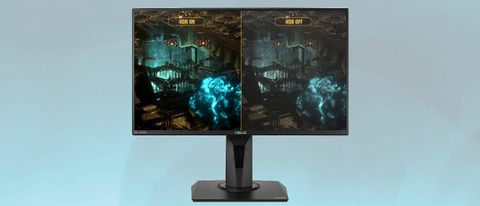Why you can trust Tom's Hardware
To read about our monitor tests in-depth, check out Display Testing Explained: How We Test PC Monitors. We cover Brightness and Contrast testing on page two.
Uncalibrated – Maximum Backlight Level
We’ve rounded up some of the fastest monitors in our database to compare the VG259QM’s performance. In the 25-inch class is the HP Omen X 25f and Acer Predator XN253Q. Also here are three speedy 27-inchers with VA panels: the Samsung C27RG5, Gigabyte G27QC and ViewSonic Elite XG270QC.



The VG259QM managed to top 400 nits in SDR mode (401.2 nits). This is more than enough light for any indoor space., and you could even use this monitor outdoors with ease. Luckily, there is enough range in the backlight settings to bottom out at 60 nits if you prefer to play in the dark.
The VG259QM has a latest-generation IPS panel, so we’re not surprised to see relatively low black levels. It beats the two TN screens in the group but lags behind the VA panels -- also, no surprise. At 1,080.2:1, the VG259QM’s contrast is a little better than the average IPS monitor.
After Calibration to 200 nits



After our calibration to 200 nits (see our recommended calibration settings on page 1), the VG259QM maintained its lead in the black level contest over the TN screens with a decent 0.2-nit score.Our calibration also increased dynamic range slightly to 1,139.8:1. This is one of the better test results we’ve seen for an IPS panel. The VG259QM definitely has a little more image depth than the HP and Acer displays here.
The VG259QM impressed us further in the ANSI test with an excellent 1,150.6:1 score. In the IPS and TN world, it doesn’t get much better. Typically, only a VA monitor manages to score above 1,000:1 in this benchmark. Our sample had decent screen uniformity, which helps here.
MORE: Best Gaming Monitors
MORE: How We Test Monitors
MORE: All Monitor Content
Current page: Brightness and Contrast
Prev Page Features and Specifications Next Page Grayscale, Gamma and Color
Christian Eberle is a Contributing Editor for Tom's Hardware US. He's a veteran reviewer of A/V equipment, specializing in monitors. Christian began his obsession with tech when he built his first PC in 1991, a 286 running DOS 3.0 at a blazing 12MHz. In 2006, he undertook training from the Imaging Science Foundation in video calibration and testing and thus started a passion for precise imaging that persists to this day. He is also a professional musician with a degree from the New England Conservatory as a classical bassoonist which he used to good effect as a performer with the West Point Army Band from 1987 to 2013. He enjoys watching movies and listening to high-end audio in his custom-built home theater and can be seen riding trails near his home on a race-ready ICE VTX recumbent trike. Christian enjoys the endless summer in Florida where he lives with his wife and Chihuahua and plays with orchestras around the state.
-
nofanneeded FHD gaming in 2020 is not acceptable :P the same way 800x600 screens are not made anymore today , also FHD should disappear and Monitors should start from 1440P.Reply
Enough already monitor makers ! Enough ! -
nofanneeded Replyplas7208 said:We need OLED monitors, not TN or IPS. This is old school for sure
Get OLED TV from LG will be alot cheaper than monitors for PC .
